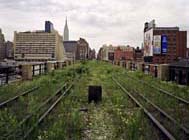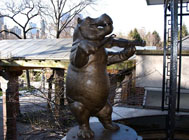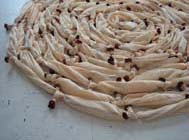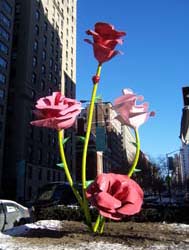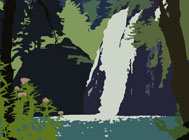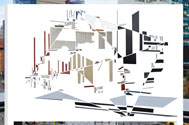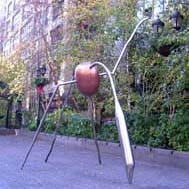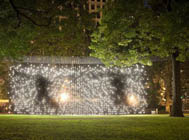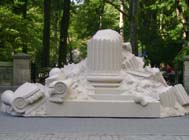Art in the Parks
Through collaborations with a diverse group of arts organizations and artists, Parks brings to the public both experimental and traditional art in many park locations. Please browse our list of current exhibits and our archives of past exhibits below. You can also see past grant opportunities or read more about the Art in the Parks Program.
Public Art Map and Guide
Find out which current exhibits are on display near you, and browse our permanent monument collection.
Search Current and Past Exhibits
2011
Manhattan
Joel Sternfeld, A Railroad Artifact
June 2, 2011 to June 30, 2011
Billboard east of the High Line at West 18th Street
The High Line, Manhattan
Please note: This is a past exhibit that is no longer installed in the park.
A Railroad Artifact, 30th St, May 2000 is the first work in Landscape with Path, a series of photographs presented on a large 25-by-75-foot billboard immediately adjacent to the High Line at West 18th Street.
Joel Sternfeld was invited by Friends of the High Line to kick off the series with one of his now-iconic images of the High Line, A Railroad Artifact, 30th St, May 2000. He was also invited to select the other two artists to follow his project. As guest curator for the series, he selected with the theme of the Landscape with Path, and invited Robert Adams and Darren Almond to exhibit their work following his own.
Joel Sternfeld photographed the High Line over the course of a year in 2000 - 2001. The images he shot of the space before its conversion into a public park show it as it was for many years: overgrown with wild plants; an untamed meadow-like space cutting through Manhattan's West Side. These images were important catalysts in conveying the potential for the space as a public green space, and helped convert many people into supporters of the movement to save it from demolition.
Landscape with Path celebrates the High Line's dual nature as an urban walkway and garden promenade, and brings the work of three celebrated photographers to park visitors on a grand scale. Each billboard will remain on view for one month, in June, August, and October, 2011.
This High Line Art Commission is presented by Friends of the High Line.
![]()
Stephen Vitiello, A Bell for Every Minute
June 23, 2010 to June 23, 2011
14th Street Passage between West 13th and West 14th streets
The High Line, Manhattan
Please note: This is a past exhibit that is no longer installed in the park.
Artist Stephen Vitiello presents a multi-channel sound installation for which he has recorded bells all over New York City and beyond. Sounds range from the iconic rings of the New York Stock Exchange bell, the historic Dreamland bell (recorded days after it was discovered in the water off Coney Island), the United Nation’s Peace Bell, and more everyday and personal sounds of bike bells, diner bells, and neighborhood church bells. During park hours an individual bell will ring each minute from speakers placed throughout the tunnel space where it will be installed, the overtones fading out as the next bell begins. A chorus of the selected bells will play at the top of each hour, filling the space. The sounds will be represented on physical sound map that identifies the location of each bell, allowing the listener to follow the geographic journey of the recordings. Collectively, the bells are a microcosm of the urban landscape as they relate to the sounds captured throughout the daily life in New York City. The site becomes activated by the composition, inviting the passerby to engage with the High Line and its connection to the city around it.
This is a project by Creative Time and the Friends of the High Line.
![]()
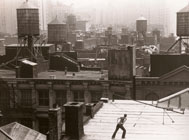
Tricia Brown Dance Company, Roof Piece
June 9, 2011 to June 11, 2011
Rooftops surrounding the southern end of the High Line, between West 13th and Gansevoort Streets., Manhattan
Please note: This is a past exhibit that is no longer installed in the park.
Performances are June 9 at 7:00 p.m.; June 10 at 7:00 p.m.; June 11 at 5:00 p.m. and 7:00 p.m..
Friends of the High Line is pleased to present Trisha Brown Dance Company's recreation of Roof Piece on the 40th anniversary of its creation. In this work, ten dancers stationed on rooftops mimic each other's movements in an improvised and mutable series of movements. The piece will be recreated on roofs surrounding the southern end of the High Line, so that park visitors will be encircled by the performance as it unfolds. These performances are free and open to the public, and do not require any reservations in advance.
After forming her own dance company in 1970, many of Trisha Brown's early works used the terrain of her adoptive Soho. These works were presented in non-traditional settings, outside of theaters, such as on roof tops and the sides of buildings. Roof Piece was first performed in 1971, in and around Wooster and Lafayette Streets.
Each performance lasts 20 - 30 minutes.
This is a project by Friends of the High Line
![]()
Ujin Lee, Tie the knots, untie the knots
June 9, 2011, noon to evening
Washington Square Park, Manhattan
Please note: This is a past exhibit that is no longer installed in the park.
Lee will carry out the performance Tie the knots, untie the knots by entering the park through the Arch, carrying one end of a long train of 3337 traditional Korean wrapping cloths, folded and tied end-to-end. She will then place the end in the center of the Arch Plaza and slowly begin to coil the train into a tight but ever-widening spiral.
The performance and installation viewing will be from noon to 3 p.m., after which the public will be invited to uncoil the installation, untie the knots, and take home the individual cloths. The event will end when all the cloths have been carried away and the space is once again empty. Lee is interested in ideas of emptiness, impermanence, and the continuous flux of movement. In this project, she explores these ideas by first occupying an empty space and filling it with tangible objects, only to relinquish the material items and pass them on to others, returning the space to its empty state.
![]()
Will Ryman, The Roses
January 25, 2011 to May 31, 2011
Park Avenue, between 57th and 67th Streets, Manhattan
Park Avenue Malls, Manhattan
Please note: This is a past exhibit that is no longer installed in the park.
Transforming Park Avenue into a fanciful garden, Will Ryman’s 38 sculptures of rose blossoms towering as high as 25 feet, complimented by 20 individual scattered rose petals, will festoon Park Avenue Mall between 57th and 67th Streets in the artist’s inaugural public art exhibition. Reflecting Ryman’s flair for the dramatic and absurdly wonderful, roses painted in shades of pink and red will spring up in vibrant contrast to the traditionally bleaker winter months preceding spring in the artist’s large-scale love letter to New York City.
Drawing inspiration from nature’s cycles and seasons, each cluster is complete with an inhabiting brass ladybug, aphid, beetle or bee for an element of both reality and humor in reference to the viewers’ own bug’s-eye-view of The Roses’ gigantic blossoms.
Ryman, familiar with non-traditional materials such as plaster, wire mesh, and PVC tubes, adopted industrial materials—stainless steel, yacht-grade fiberglass resin, automotive paint, and brass—creating sculptures designed to withstand the elements and be enjoyed by viewers throughout the seasons. The Roses will be on view from winter’s dormancy through spring’s regeneration, suggesting the cycle of nature, as well as the eternally changing landscape of New York.
![]()
Kota Ezawa, City of Nature
March 31, 2011 to May 15, 2011
Madison Square Park, Manhattan
Please note: This is a past exhibit that is no longer installed in the park.
Kota Ezawa is a German-born, San Fransisco-based video artist and illustrator who creates simple, graphic illustrations over film footage to produce short, witty narrative videos. City of Nature, Ezawa’s original video commission for Mad. Sq. Art, weaves together excerpts from popular films, ranging from Fitzcarraldo to Twin Peaks in which nature is the only character featured onscreen. These short clips are edited together to form what the artist calls a “video collage” or seamless montage, before being translated through freehand, computer assisted digital animation. The resulting animated video stands as a visually striking and original work containing subtle, but deliberate echoes of iconic cultural moments embedded in our collective unconscious. In much the same way that Madison Square Park presents a cultivated and aestheticized side of nature, wildlife and green space amidst the urban landscape of central Manhattan, City of Nature examines the ways in which popular culture presents aestheticized images of the natural work, “unnatural” visions of nature that embed themselves in our cultural memory and media landscape more deeply than we may consciously know.
This is a project of the Madison Square Park Conservancy.
![]()
Richard Galpin, Viewing Station
May 7, 2010 to May 1, 2011
High Line, between 17th and 18th streets
The High Line, Manhattan
Please note: This is a past exhibit that is no longer installed in the park.
Richard Galpin alters photographs of cityscapes. His chosen method of manipulation is to cut and remove the top layer of the colored emulsion from his photographic prints, exposing the paper substrate. By eradicating part of the photograph, its imagery becomes transformed to the point of total abstraction. Using clean lines and sharp angles, Galpin’s technique emphasizes geometric forms, recalling early 20th century art movements such as Constructivism, Cubism, and Futurism.
For the High Line, Galpin has created a viewing station that functions similarly to his cut photographs. Park visitors are invited to look through the opening on top of the viewing post, which is lined up with a metal screen from which geometric shapes have been cut. The combination of these two devices abstracts the view of nearby buildings.
Through relatively simple means, the viewing station distorts optical perspective, making it difficult to judge spatial distance. Its isolation of fragmented areas encourages more acute observation of surface details, and subtleties of color and texture. The view looks more like a two-dimensional image – such as a photograph or painting – than three-dimensional space.
This project is presented by Friends of the High Line. For more information, visit Friends of the High Line's public art page.
![]()
Gloria Kisch, Copper Fusion
November 24, 2010 to March 12, 2011
Dag Hammarskjold Plaza, Manhattan
Please note: This is a past exhibit that is no longer installed in the park.
Parks is happy to welcome back Gloria Kisch to the Dag Hammarskjold sculpture plaza. In 2002 Gloria exhibited Octopus II, a monumental stainless steel sculpture from a series called Octopi. Her new work Copper Fusion is made of stainless steel and reaches 14 feet in height.
![]()
Jim Campbell, Scattered Light
October 21, 2010 to February 28, 2011
Madison Square Park, Manhattan
Please note: This is a past exhibit that is no longer installed in the park.
Scattered Light is the New York public art debut of pioneering new media artist Jim Campbell. Campbell’s exhibition features three new major public art commissions, including his largest and most ambitious work to date.
With Scattered Light, Campbell has hung nearly 2,000 LED lights, encased in standard light-bulb casings, from a massive suspension truss standing 20 feet high and stretching 80 feet down the center of the Oval Lawn. These LEDs have been programmed and sequenced by Campbell to turn and off in such a way that from the pathways of Madison Square Park—and from the major avenues beyond the park’s boundaries—it will appear as though the shadows of people and animals are passing across a massive, gently-undulating amorphous field of light.
Broken Window will be an additional work, situated near the main entrance to Madison Square Park at 23rd Street and Fifth Avenue, in which an array of LEDs encased in a glass-brick wall create illuminated moving images that gently pass across the glass plane. Voices in the Subway Station Eighteen features eighteen glass tablets embedded in the grass that emit gentle pulses of light—communicating like passengers on the subway.
This is a project of the Madison Square Park Conservancy.
![]()
Ryan Gander, The Happy Prince
September 15, 2010 to February 13, 2011
Doris C. Freedman Plaza, 60th St. and 5th Ave.
Central Park, Manhattan
Please note: This is a past exhibit that is no longer installed in the park.
“High above the city, on a tall column, stood the statue of the Happy Prince. He was gilded all over with thin leaves of fine gold, for eyes he had two bright sapphires, and a large red ruby glowed on his sword-hilt.” So begins the best-known children’s story by the renowned literary figure, Oscar Wilde (1854–1900). It seems fitting that British artist Ryan Gander (b. 1976) has taken inspiration for his first public commission from the tale of an enchanted monument.
Here Gander has re-imagined the final, climactic moments of Wilde’s story where the statue is destroyed. Aided by a friendly swallow, the prince has given away all of his jewels and gilding to alleviate the suffering of the city’s poor. No longer impressive to city officials, Wilde’s denuded metal statue is melted down.
In Gander’s version, the statue appears to be stone; the fallen swallow and the prince’s indestructible heart lie amidst the rubble. On closer inspection we see that the “ruin” is a single massive object: a sculpture of a ruin. In this way, it functions like a plastic toy ruin, at once descriptive and frankly artificial. Gander’s wry evocation of Wilde’s tale still resonates in our own period of economic inequality. At the same time, it presents a contemporary approach to sculpture, where the role of the public monument remains an open question.
This is a project by the Public Art Fund.
![]()
